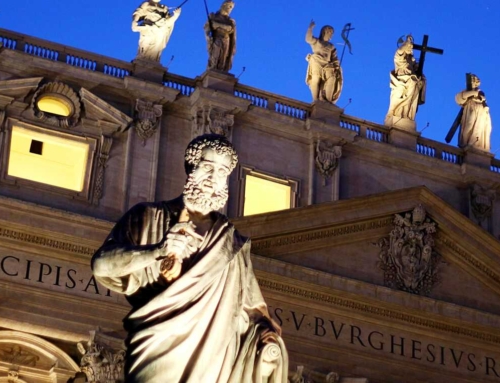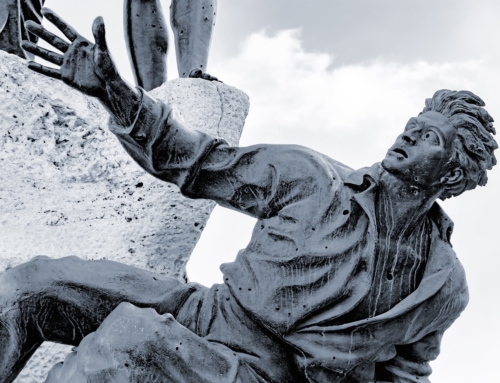Arguably history’s most beloved and fascinating saint, we sometimes forget that Joan of Arc was not a legend. She was a real person with a real calling from God to do something heroic for Christ’s Kingdom.
But Joan didn’t take any up her sword on her own initiative. She was not a political phenomenon or an entrepreneur who built an empire. She was a servant of Christ, who received a mission from her Lord and fulfilled it to the fullest measure.
That is why we love Joan. It’s not only because she was such an interesting person and a contradiction to all the norms of her day. It’s because she was faithful.
The following vignettes come from a little book I wrote on her leadership skills, The Seven Leadership Virtues of Joan of Arc. They will give you a brief glance into her spiritual dynamism, and I hope they will stir you to find out more about this wonderful saint.
The Banner
It was twelve feet long, silky white, and emblazoned with the names of Jesus and Mary – a warrior’s banner. It was mounted on a tall pole for all to see, the resolute declaration of a conquering hero, like David against Goliath: “You come against me with sword and spear and scimitar, but I come against you in the name of the Lord of hosts” (1 Samuel 17:45).
Thus did Joan of Arc ride into battle – holding high the banner, declaring her identity as a Christian soldier. Joan knew who she was, and announced it to her friends and enemies alike. Such a bold, bright, obstinate declaration of a warrior’s character must have struck mortal fear into the hearts of every foe, as the maiden, clad in armor and fire, rode onto the battlefield bringing war to their strongholds.
The English occupiers of France were so terrified by this banner, and the maiden carrying it, that they convinced themselves she had to be a witch. Surely, no woman had such power and authority! And in that insight alone were they correct. Her authority was not her own.
It came from her identity and her God: no witch ever identified herself with the holy names of Jesus and Mary.
The Sword
“I bring a message from La Pucelle [the Maid],” said the emissaries to the abbot of the monastery.
“I have heard tell of her claims to be the Maid who will save France,” responded the aged monk with a gentle nod. “What is her request?”
“The Maid respectfully asks Your Reverence to remove the stones from the back of the sanctuary behind the altar, and digging, you will find there a sword imprinted with fleurs-de-lis and having five crosses on the blade. When you have done so, we are to bring the sword to the Maid for lifting the siege of Orléans.”
“She wants me to dig up the church sanctuary to find a buried sword?!” exclaimed the cleric. “What an odd request!”
“Nevertheless, it must be done! So orders the Maid.”
The priest in charge of the Shrine of St. Catherine of Fierbois reluctantly called in several men who carried out the Maid’s strange appeal only to find it just as she had said. The workers dug up from below the altar a rusty old sword that had seen better days. But the fleurs-de-lis – the symbol of France – were evident. And when they removed the light coating of rust – behold! – five crosses were etched on the blade.
The Horse
It must have been a magnificent creature.
The horse given to Joan of Arc by the Duke of Lorraine was not a battle-horse, a mighty steed, but a smaller charger – sleek, agile, quick as lightning, and beautiful. The diminutive Maid would not have even been able to handle one of the great war horses! But she immediately took to her dark-coated charger and made him her own. Or did he make her his own? It is hard to say. But from that day, they became united in the same mission to save France.
Her family did not own a horse, and it is not clear whether Joan had ever ridden one before she received this gift from the Duke, but when she hopped on her charger, a hidden natural gift of horsemanship came to life in her. God knew what she needed for her mission. She needed to be mobile.
The Authority
On April 29th, 1429 the Maid rode through the eastern Burgundy Gate of the city of Orléans – still under siege – accompanied by several hundred of her troops, with military commanders and adjutants at her side. Thousands of the hungry, frightened residents of the city lined up to joyfully greet the Maid as she swept into their town like a force of nature to let the people know that their cause was now engaged by a leader with real authority.
Nothing like that military parade had even been seen in the history of warfare. It was certainly not the largest military procession ever to take place, but it must have been a pageant of epic emotional and spiritual proportions.
The impressive French knights rode in on their war horses emblazoned with silky, colorful heraldry; the grim soldiers held their weapons aloft and sang songs from the heart of their homeland; and the famed Maid on her black charger, in gleaming armor, unfurled her twelve-foot banner in the wind to the wonderment of the entire city. She came by authority of the King of France and in the names of Jesus and Mary.
All fear of a besieging enemy vanished.
Soul Work
Do you still retain the enthusiasm of your youth for the Christian faith, or are you like the church of Ephesus in the Book of Revelation who Christ admonished because they had “lost the love [they] had at first” (Rev 2:4)?
Saints like Joan of Arc refresh us with their purity. They astound us by their heroic virtue and innocent embrace of God’s will, no matter how demanding the mission.
Do an inspiration check on your faith today and make sure you have in your life multiple sources of saintly inspiration to keep the fires of your faith burning brightly. Joan of Arc is one of my own motivational saints who never ceases to spur me on to virtue – who is yours?
———-
[This article is a companion piece to the Sacred Windows Email Newsletter of 05/30/21, “The Feisty Maid of Orleans: Joan of Arc’s Legacy.” Please visit our Newsletter Archives.]




[…] Joan of Arc was neither a knight nor a trained soldier, but when she mounted a horse for the first time she was so natural on it that the Duke of Lorraine gifted it to her. […]
[…] Joan of Arc was neither a knight nor a trained soldier, but when she mounted a horse for the first time she was so natural on it that the Duke of Lorraine gifted it to her. […]
[…] Joan of Arc was neither a knight nor a trained soldier, but when she mounted a horse for the first time she was so natural on it that the Duke of Lorraine gifted it to her. […]
[…] Joan of Arc was neither a knight nor a trained soldier, but when she mounted a horse for the first time she was so natural on it that the Duke of Lorraine gifted it to her. […]
[…] Joan of Arc was neither a knight nor a trained soldier, but when she mounted a horse for the first time she was so natural on it that the Duke of Lorraine gifted it to her. […]
[…] Joan of Arc was neither a knight nor a trained soldier, but when she mounted a horse for the first time she was so natural on it that the Duke of Lorraine gifted it to her. […]
[…] Joan of Arc was neither a knight nor a trained soldier, but when she mounted a horse for the first time she was so natural on it that the Duke of Lorraine gifted it to her. […]
[…] respect from her troops who realized she was not using them as mere cannon fodder. She carried a banner and sword into battle and waved her banner to encourage the French that God was on their side. She […]